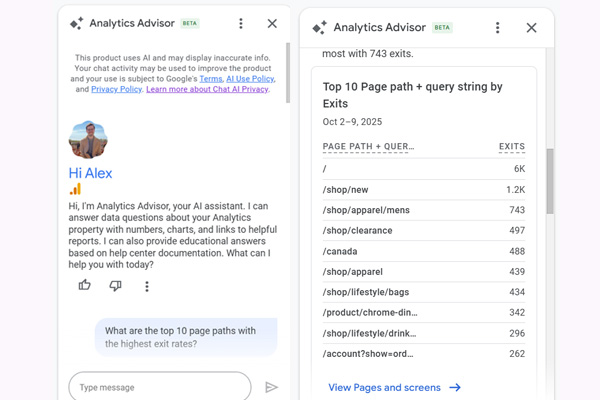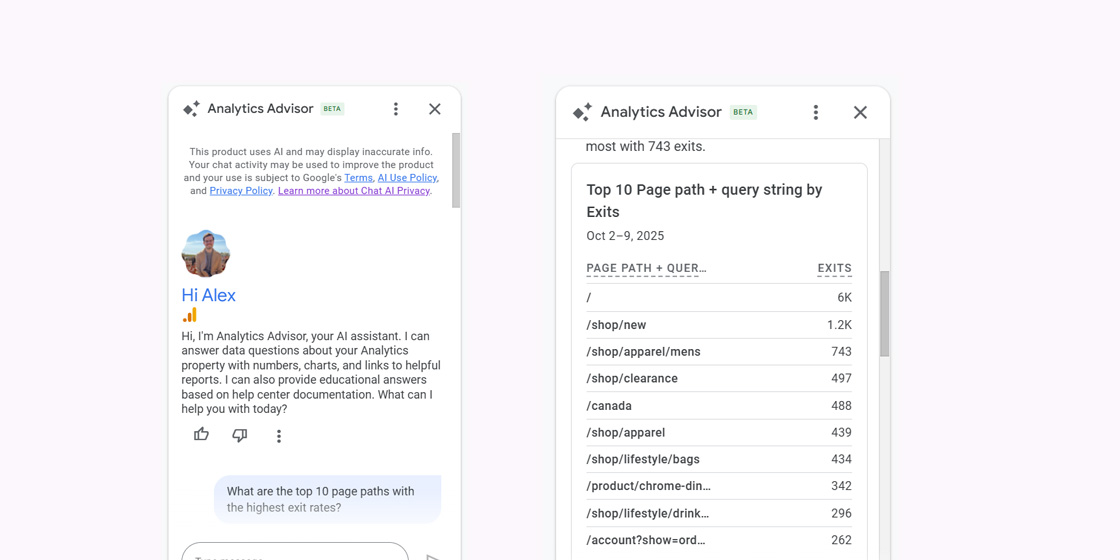If you're like us at GA4 Optimizer, you probably spend more time in Google Analytics than you'd like to admit. We're always looking for ways to make the platform easier to use. So when a new, unannounced feature called Analytics Advisor (Beta) chatbot quietly appeared in our account we wanted to see see how useful it's going to to be.
There was nothing online about it. No blog posts, no announcements, news, just a new AI chatbot sitting inside our GA4 property. Is this the future of analytics? Can it replace a skilled analyst? We had to know.
We decided to put it through its paces with a few real-world questions we ask every day. Here’s a completely honest first impression of how it performed.
Test 1: The Everyday Traffic Question
We started with a simple, everyday marketing question.
Our Prompt: "What are the top ten landing pages for users from Paid Media channels?"
The Result: The Advisor said it couldn't retrieve info for all "Paid Media" channels but immediately pivoted to "Paid Search." It gave us a top 10 list and then, to our surprise, it proactively generated charts showing all our channel groups, a daily trend for Paid Search users, and a week-over-week summary.
Our Verdict: It Was Smarter Than We Expected.
This was a clever response. After looking at the channel data it provided, we realized "Paid Search" was the only paid channel with any real traffic. The AI figured this out on its own and gave us a useful answer instead of just saying it couldn't find anything for "Paid Media."
However, If our account had traffic from "Paid Social," "Display," or messy "Unassigned" channels, we are not certain if the AI would have known to group them or to manually segment Medium and Source dimensions like a human analyst typically would.
Test 2: The E-commerce Funnel Deep Dive
Next, we decided to ramp up the difficulty with a critical e-commerce question.
Our Prompt: "Analyze the checkout funnel for users who added a specific product Item ID 'GGOEGXXX2476' to their cart. Where is the most significant drop-off point for mobile users compared to desktop users, and what user properties or events correlate with this drop-off?"
The Result: It nailed the first part. It correctly found that 49 people added the item to their cart, but zero started the checkout. It pinpointed a 100% drop-off right after the add-to-cart step.
But on the second part of the question, it fell flat. It admitted it couldn't find any user properties related to the drop-off and gave generic advice like "check if the button is working."
Our Verdict: It Finds the 'What,' Not the 'Why'.
The AI was great at spotting a massive red flag that any marketer would need to investigate immediately. But the real value comes from discovering why it's happening. Is a specific browser bugged? Is a certain country seeing errors? The Advisor couldn't connect those dots, which is where basic reporting ends and real analysis begins.
Test 3: The Behavioral User Comparison
We wanted to see if the AI could handle a more strategic query about user behavior.
Our Prompt: "Compare the typical user journey of a customer who makes a high-value purchase versus a low-value purchase. What are the key event and page view differences in their first three sessions?"
The Result: The Advisor came back with, "I was unable to retrieve the data to compare user journeys." It then gave me a generic list of the top events and pages for all users, which wasn't what we asked for.
Our Verdict: Not Quite Ready for Complex Segmentation.
The ability to create and compare user segments on the fly is fundamental to understanding what drives valuable actions. For now, this kind of work is still firmly in the hands of a human using GA4's Exploration reports.
Test 4: The Data Quality Check
We shifted our focus to a more technical question about data integrity.
Our Prompt: "For our 'add_to_cart' event, what percentage of events are missing the 'item_value' parameter? Can you segment this by device category?"
The Result: A perfect answer. It came back immediately: "0% of events are missing the 'item_value' parameter across all device categories." It then provided extra context with device breakdowns and trend charts.
Our Verdict: A Genuine Time Saver.
This was a fantastic use case for the AI. It answered a critical data quality question instantly and accurately. To do this manually, we would have had to build a custom exploration with filters, which would have taken much more time. This was a clear win.
Test 5: A Test of Nuance: Can it calculate a new metric?
Google Analytics currently doesn't have a beloved metric called "Exit Rate", can this AI pull it automatically for us?
Our Prompt: "What are the top 10 page paths with the highest exit rates?"
The Result: This is where things got a bit dangerous. It told us it couldn't get the pages with the highest exit rates, but it could get the pages with the highest number of exits. It then gave us a list of pages ranked by their total exit count.
Our Verdict: While close, not close enough.
This is a slight problem. Exit Rate and Number of Exits are completely different things. Your homepage will always have a high number of exits because it gets the most traffic, but its exit rate is likely very low. A page with a high exit rate is a red flag, telling you that people are leaving your site from that page more often than expected.
By providing the wrong metric, the Advisor could send a marketer on a wild goose chase. Currently, Exit Rate actually doesn't exist in Google Analytics 4, it's the exact reason we built the 'Quick Calculated Metric' feature into our GA4 Optimizer extension. An analyst could instantly create the Exits / Views calculation on the fly, find the true problem pages in seconds, and get the right answer.
Test 6: The Audience Profile Snapshot
Finally, we wanted to see if the AI could help us understand our predictive audiences better.
Our Prompt: "We see an audience name called Likely 7-day purchasers (test). What are most common traits among this audience?"
The Result: Another home run. The Advisor instantly pulled up charts and lists showing the top 10 countries, device categories, and browsers for that specific audience. It even showed me a daily trend of how that audience has grown over time.
Our Verdict: Excellent for Quick Profiles.
This is incredibly useful. For any marketer, getting a quick, easy-to-read snapshot of a predictive audience is a huge win. It lowers the barrier to understanding who you're actually talking to, and it does it in seconds.
The Chat Experience:
Beyond just the answers, the user experience of the chatbot itself is worth talking about. One thing that really stood out was the presentation. The Advisor doesn't just give you text; it generates real charts and graphs that look and feel exactly like the ones in the main GA4 interface, right down to the interactive tooltips. It even shows you its "thinking" process, listing the steps it's taking to find your data, which is a nice touch for transparency.
The feature is still in Beta though so there are some small cracks. Sometimes the charts and tables do not fit the chatbot box. Also, below many of the charts is a tempting "See more" link. But when you click it, it just sends you into a generic, unrelated standard report.
We also really wish the chatbot would ask more questions before taking its full time to think. We did not specify the specific date range and wish it would clarify with me which date range we're interested in so we don't have to wait another 30 seconds to reprompt it again with a proper date range.
Privacy and Enterprise Readiness
So, is this tool ready for your business to use? Before you start typing in sensitive queries, you need to look at the fine print. Google's disclaimer is very clear: "Your chat activity may be used to improve the product."
For many enterprises, this is a non-starter. The idea that your private analytics data could be used to train a general AI model raises serious security and privacy concerns. Until Google offers a clear option for a secure, private instance, the Analytics Advisor will likely remain a tool for non-sensitive exploration, not for deep, proprietary business analysis.
Final Conclusion: Is Analytics Advisor Ready for Prime Time?
For Marketers: The Analytics Advisor shows huge promise as a quick-access assistant. For high-level summaries, audience profiling, and basic data validation, it can provide answers in seconds that would otherwise take minutes to dig up.
For Analysts: Your job is safe. It is not ready for complex segmentation and can't usually answer the crucial "why" behind the data. And for enterprises concerned with data privacy, its current data usage policy makes it a non-starter for sensitive analysis.
Overall, the Analytics Advisor is a fascinating glimpse into the future of GA4. It seems like it's the next step after Google released the MCP Server but it's far too technical so we're happy to see this UI experience. It's a powerful tool for quick simple data pulls and checks, but it's no replacement for a skilled analyst or the powerful, manual control offered by GA4's Explorations.
And while we wait for this feature to evolve, you don't have to. Our GA4 Optimizer Chrome Extension is already here, built to bridge the gaps in the GA4 interface. From adding "Percentage of Column Total" in one click to creating "Quick Calculated Metrics" on the fly, our goal is to empower you to get to the "why" faster than ever.
Have you seen the Analytics Advisor in your account? Go check it out! And if you want to supercharge your current GA4 workflow completely free, install GA4 Optimizer today.
Frequently Asked Questions (FAQ)
Q: What is Google Analytics Advisor AI and how does it work?
A: Google Analytics Advisor AI (Beta) is an unannounced chatbot feature that appeared in select GA4 accounts. It can answer basic analytics questions, generate charts, and provide quick data summaries. However, it struggles with complex segmentation, misunderstands key metrics like exit rate vs. exits, and cannot perform deep analytical reasoning about the 'why' behind data patterns.
Q: Can Google's Analytics Advisor AI replace a human analyst?
A: No, Analytics Advisor AI cannot replace a skilled analyst. While it excels at quick data retrieval and basic summaries, it is not ready yet for complex segmentation, running custom calculations, and answering strategic 'why' questions. It's best used as a quick-access assistant for high-level overviews and basic data validation, not for comprehensive analysis.
Q: Is Google Analytics Advisor AI safe for enterprise use?
A: Currently, no. Google's disclaimer states that 'chat activity may be used to improve the product,' meaning your private analytics data could be used to train their AI model. This raises serious security and privacy concerns for enterprises. Until Google offers a secure, private instance option, it's not suitable for sensitive business analysis.

